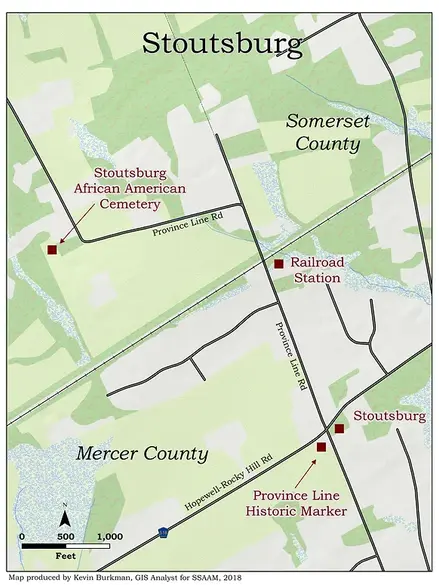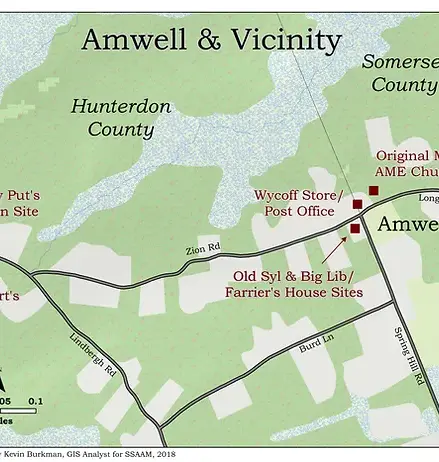
The Places
Where did people live and work in the Sourlands?
African American Sites in the Sourland Region
The name Sourland is believed to be derived from 17th century Dutch settlers, who referred to the area as "sauer landt" because the hardscrabble region was clearly not suitable for farming.
In the centuries to follow, others settled in the region and tried to work this hardscrabble landscape, including African Americans, both as slaves and as freed people. Places specific to African Americans can be found all over the Sourland region. A church where they once worshiped can be seen on Hollow Rd.; that site, the Mt Zion AME Church, will soon be home to the SSAAM. The places where they still worship are found in Pennington and Hopewell. The region is home to numerous African American cemeteries and grave sites, including those of soldiers who participated in the Revolutionary and Civil Wars. African American villages on Sourland Mountain and in the valleys, long since disappeared, continue to carry their original place-names.
Site Descriptions

William Allen
Higgins Farmhouse (private property): Located on Spring Hill Road in Montgomery Township dates back to the 19th century and is believed to be a site on the Underground Railroad.
Honey Hollow: During the mid 19th century, as many as 50 African Americans lived in now-abandoned Honey Hollow, which was located near Titusville. Remnants of the village can still be found in the woods that have overtaken it, along Fiddlers Creek Rd. The site is located just off of Fiddlers Creek Rd, in Mercer County's Ted Stiles Preserve at Baldpate Mountain.
Lindbergh Site (private property): On May 12, 1932, Pennington resident William Allen found the body of Charles Lindbergh Jr. along Hopewell-Princeton Rd., 72 days after the child’s infamous kidnapping. An African American man, Allen was shunned by the Lindbergh family after his discovery.
The State of New Jersey and the Lindberghs had originally offered a combined total of $75,000 in reward for the safe return of the child. Governor Harold Hoffman would eventually intercede on behalf of Allen for a portion of the reward. For his discovery, one that saved the state of New Jersey hundreds of thousands of dollars in continuing search expenses, Allen received $5000.
The unmarked site is located off of Hopewell-Princeton Road, just south of Hopewell Borough in Mercer County.
Site Descriptions

Minnietown (private property): Minnietown was a community of about 25 African American and Native American families on Sourland Mountain during the late 1800s. The history of Minnietown has been passed down through stories in the African American community, and versions that can be found in writings by white historians. The community may have been named after resident Minnie True, or possibly a Native American tribe, the Minnepenason. The African Americans who lived in Minnietown most likely dispersed after a peach blight in the 1890’s.
The village was located at Hopewell-Wertsville Road & Minnie Town Lane, in Hopewell Township.
Truehart House (private property): Friday Truehart was a slave purchased by Old School Baptist preacher Rev. Oliver Hart. Friday was brought to Hopewell from Charleston, SC at the age of 13. Hart later resided in a log cabin in the Sourland Mountains.
The site is located on Mt. Church Road, Hopewell Township.
Woodsville: Woodsville formed shortly after the turnpike was built. It flourished throughout the rest of the century, with a post office, blacksmith shops, and school. African Americans lived nearby and a cemetery holds some of their remains (under research). The village was mostly abandoned by the early 20th century. Woodsville is located west of State Route 31, in Hopewell Township.
Rocktown: Site of a Lenni-Lenape village called Wishelmenesey. By the mid 1800s the village contained a store, tavern and later a post office. It was there that a Confederate flag is said to have been flown during the Civil War, one of two places in the Hunterdon County showing such sympathies.
Rocktown has behaved in a much more sedate manner appearing when and where it should on early maps and in books of early days. In a Gazetter of the state of New Jersey which was published in we read the following: "Rocktown-Small Hamlet of Amwell Township-Hunterdon County, mi. S. of Flemington, contains tavern, store and some or dwellings. It lies in the pass through the Rock Mountain and is named for the abundance of large rocks around it."
Rocktown is located in West Amwell Township, west of State Route 31.
Zion: Zion was located in Montgomery Township, where Hollow, Long Hill, and Dutchtown-Zion roads meet. Developed in the early 19th century, the village took advantage of the hydro power of Rock Brook, which flows to the east of Hollow Road Four mills, a blacksmith, numerous houses, and a nearby school developed in and around Zion. The only public building that still exist from the era is the Mount Zion Methodist Episcopal Church, on Zion Road.
Sources: SSAAM, Sourland Conservancy/Andrea Bonette, T.J. Luce, Hopewell Borough, Descendants of the Signers of the Declaration of Independence, West Amwell Township, Pennington Community Directory.





